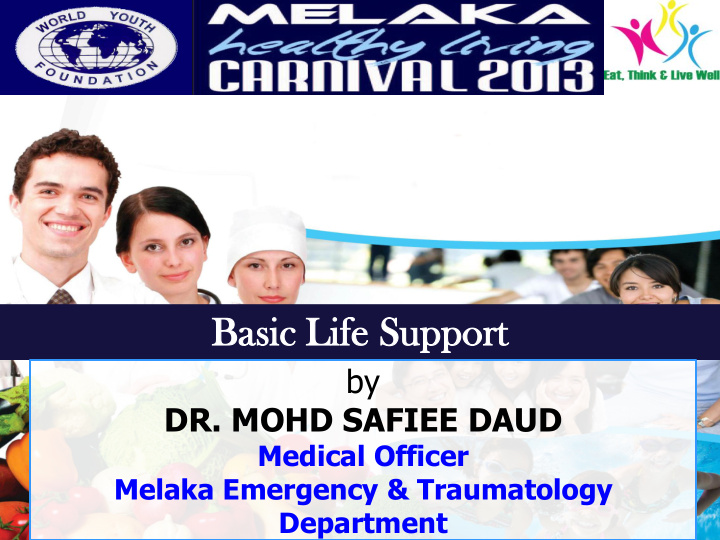



Melaka Healthy Living Carnival 2013 Ba Basic ic Li Life fe Su Suppo pport by DR. MOHD SAFIEE DAUD Medical Officer Melaka Emergency & Traumatology Department
CPR LECTURE Hos ospi pita tal l Me Melak aka a
Teori asas yang kita perlu tahu… Anatomy dan physiology jantung dan paru2 1. Penyakit koronari, cara hidup sihat dan 2. tindakkan kecemasan ‘Choking’, pencegahan dan tindakkan. 3. Konsep ‘clinical/ biological death’ 4. ‘Chain of survival’ 5. DR. ABCD of CPR dan teori 6.
Paediatric NRP PALS CPR BLS Trauma ALS TLS MTLS ATLS
Lidah
Sebab2 penting kematian mengejut Serangan jantung ‘Choking’ Stroke Drowning Electric shock Trauma (bleeding) Drug poisoning
Serangan jantung
Atherosclerosis
BLOOD VESSEL DISEASE Atherosclerosis RISK FACTORS Kenali dan kawal faktor risiko
Serangan jantung (Artherosclerosis) di sebabkan oleh DIABETES 1. HYPERTENSION 2. MEROKOK 3. HYPERLIPIDEMIA 4. OBESITY 5. SEDENTARY LIFE STYLE 6. 7. STRESS
Healthy life targets to achieve RISK ALL AT RISK SMOKING NO DIABETES <6.5% (RBS/FBS/HBA1c) HYPERTENSION <140/90 <130/80 T. CHOLESTEROL 5.4mmol/l <4.5 LDL-CHOLESTEROL 4.1mmol/l <2.6 HDL CHOLESTEROL 1.1mmol/l >1.1 AEROBIC EXERCISE 30 min, 3 X a week OBESITY LOSE 5 % LOSE 10%
Simple advice 1. Aerobic exercise: at least 20min 3 X a week. 2. Avoid meat fat and chicken skin. Reduce sugar, salt and oil intake. 3. Limit egg yolk, shelled sea food, fried foods. 4. Chose marjarine over butter. 5. Chose boiling, steaming, roasting and saute over frying 6. and curry. Relaxation and finding peace in our work and homes. 7. Learning to say no and being positive. No smoking 8. No alcohol or in moderation only. 9.
Langkah kecemasaan untuk mangsa disyaki mengalami serangan jantung Kenali tanda serangan jantung Duduk atau baring Dapatkan Asprin 300mg, kunyah atau bancuh dengan air. Satu biji GTN tablet di bawah lidah jika ada. Ulangi setiap 5 minit jika perlu sebanyak tiga kali. Panggil ambulan (999) ATAU bawa mangsa ke Jabatan Kecemasan Hospital terdekat.
4 min brain death begins 10 min brain death certain I want oxygen! 0 2 Room - 21% Expired air - 16%
Chain of survival Early Early Early Early Defibrillation ALS Access CPR AED
CHANGES IN NEW GUIDELINES 2010
1. Cardiac arrest will be recognized by unresponsiveness and absence of normal breathing 2. Gasping and agonal breaths will be highlighted as abnormal breathing and indicators of cardiac arrest . 3. Carotid pulse check will not be performed prior to beginning chest compressions. 4. Chest compressions will begin immediately after the absence of normal breathing. 5. Chest compressions will resume immediately after delivery of the first shock from a defibrillator.
DR S ABCD 1. D - DANGER 2. R - RESPONSIVENESS 3. S - SHOUT FOR HELP 4. A - AIRWAY 5. B - BREATHING 6. C - CIRCULATION 7. D - DEFIBRILLATION
DANGER a. Wearing Personal Protective Equipment (PPE) , eg: mask, apron, and gloves ( the availability will be depend on the situation ) b. Avoiding spills of body fluids, sharps and electrical wires (at bedside) c. Determining unstable beds and trolleys
RESPONSIVENESS Responsiveness will be assessed by tapping both shoulder twice and calling ‘ Hello are you OK ‘ or ‘ Tuan / Puan OK ‘
SHOUTING shout the following words after suspecting a cardiac arrest or patient not responding to call . “Emergency ! Emergency ! Bring the resuscitation trolley and defebrillator ! . / call 999 and get an AED !”
AIRWAY Open the airway after shouting for help using the head tilt , chin lift manouver ,
BREATHING -Assess by looking at the chest , neck and face for not more than 10 seconds. -The absence breathing or presence of abnormal breathing will indentify cardiac arrest . -Agonal gasp is a sign of cardiac arrest . -Begin chest compression immediately with absence of normal breathing . Checking pulse is not recommended prior to initiation of first chest compression.
CHEST COMPRESSION 1.Place the heel of your hand in the centre of the chest with other hand on top . 1. A rate of at least 100-120 compression per minutes. 2. Depth at least 5 cm. 3. Complete recoil of the chest must be allowed after compression 4. Interruption of chest compression shall be minimized during the entire resuscitation attempt. 5. Ratio of chest compression to ventilation shall be 30 : 2
VENTILATION a. Use personal protective devices where available b. Each breath shall be given within 1 second inspiratory time until you observe a chest rise. c. Mouth to mouth ventilation shall be taught for outside of the hospital and in hospital areas without bag-mask devices.
DEFIBRILLATION Early defibrillation is an essential step in the chain of survival for victims of cardiac arrest. Chest compression should immediately resume after 1 shock .
Reassessment during CPR After every 5 cycles or 2 minutes of CPR , rescuers should check for normal breathing. When to do pulse check For healthcare professionals it is reasonable to check a pulse if an organized rhythm is visible on the monitor at the next rhythm check.
When to stop CPR a. When the victim recovers with normal breathing b. Rescuers is exhausted c. When advanced life support assistance arrive Rescuers shall be encouraged to switch chest compression every 5 cycles or 2 minutes to avoid fatigue .
RECOVERY POSITION Recovery when victims resume normal breathing but remain unresponsive . The technique taught must ensure the following : a. Victim in true lateral position b. Position is stable c. Position is safe and comfortable d. Head in dependant position
Special situations Vomiting 1. Neck injury 2. Dentures 3. Drowning 4. Refuse mouth to mouth ventilation 5. When to stop CPR 6.
How do we count………..? For determining time…one in a thousand, 1. two in a thousand…. We count for not more than 10 seconds when assessing for signs of breathing. For chest compression…1, 2, 3, 4 … 13, 14, 2. ..29,30 30 chest compressions and 2 ventilations ..
THANK YOU
Recommend
More recommend